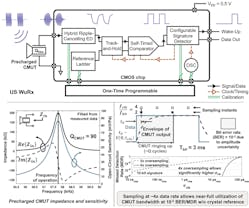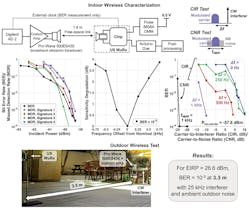Even power-miserly IoT devices in quiescent mode can drain their battery over time, so the challenge is to have their wakeup circuitry—which is on the alert for a coded signal—use absolutely minimal power. The conventional approach is to always have the IoT device looking for a coded RF signal which, when recognized, tells it to wake up, fulfill its function, then go back to sleep.
But a paper presented at the recent International Solid-State Circuits Conference (ISSCC) by researchers from Stanford University detailed the use of ultrasound as an alternative approach to RF wakeup receivers (WuRXs), resulting in lower power requirements and smaller size than the RF technique. The paper, by Amin Arbabian, Assistant Professor of Electrical Engineering, and graduate student Angad Singh Rekhi, discusses use of the highly sensitive ultrasonic transducers to detect a wakeup signature while using as little as 1 nW for the associated electronics (click here to view the paper, posted at Stanford’s Arbabian research-paper listing page).
This approach requires less power and has smaller size compared to RF antenna miniaturization, which is limited by high antenna Qs at low size-to-wavelength ratios. Efficiently matching to these antennas requires high-Q passives that are generally unavailable at mm-scale.
1. The block diagram of the ultrasound-based wakeup receiver shows its dependence on a micromachined transducer plus minimal electronic circuitry, to achieve ultralow power consumption (top); the spectral response and performance of the CMUT centers around the 57.75-kHz operating frequency (lower left); the lower right image shows how the received signal-processing sequence achieves low error rate.
The ultrasonic (US) WuRX is based on a precharged, capacitive micromachined ultrasound transducer (CMUT) developed and fabricated by another Stanford group, and has power consumption of just a few nanowatts. Since the CMUT size is on the order of the nominal 57.75-kHz ultrasound wavelength (~7 mm), the entire WuRX implementation with the IC on top of the CMUT has a footprint of just 14.5 mm2, significantly smaller than the active area (chip plus antenna/transducer) of existing RF- and ultrasound-based designs. Another advantage is that ultrasound has no limits for EIRP (equivalent isotropically radiated power) in air, and is obviously immune to performance degradation due to EMI/RFI.
The CMUT output (Fig. 1) connects directly to a ripple-cancelling envelope detector (ED); the dc output is compared to a pseudoresistor ladder-based reference voltage by a low-noise comparator clocked by a simple, relaxation oscillator at 1.344 kHz. The comparator output is then clocked into a variable-length detector that looks for one of multiple selectable signatures and produces a 0.5-V wakeup pulse upon signature recognition.
To reduce power requirements, the chip doesn’t use closed-loop timing recovery or even a crystal. Instead, the timing issues are resolved by oversampling the data. The missed-detection rate (MDR) is a function of timing uncertainty (drift and jitter), signature length, and sampling rate. Sampling the incoming data at four times the bit rate allows almost full use of the CMUT bandwidth, resulting in an MDR of 10-3. The comparator output is clocked into a detector that compares sequences of every fourth bit (in accordance with 4× oversampling) to one of four hard-coded signatures.
2. Shown is the test arrangement and equipment used to characterize the performance of the ultrasound approach across various parameters, including the addition of an interfering ultrasound signal.
The WuRX chip, fabricated by TSMC using a 65-nm CMOS general-purpose process, runs on 0.5 V and measures 1 × 1.5 mm. Dissipation of the IC plus CMUT is under 8 nW. Long-range test results show viable functionality in an outdoor setting despite ambient acoustic noise and a strong 25-kHz interferer, with a data rate of 62.5 bits/s—more than adequate for the application (Fig. 2). The team reports sensitivity of −58.4 dB for this WuRX, which improves on the state of the art by 7.6 dB.



